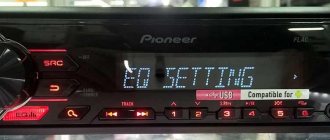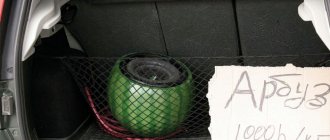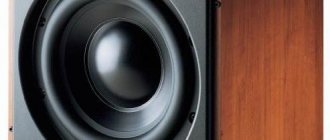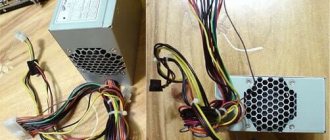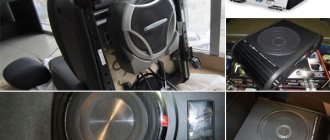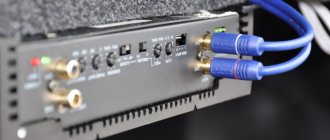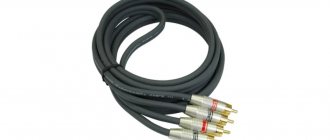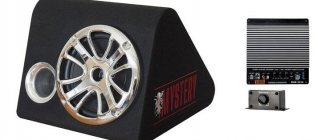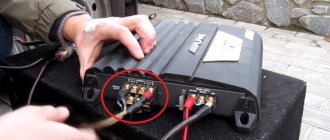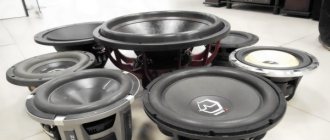A good subwoofer in a car will allow you to get a mobile music center or even create a kind of car cinema with deep sound. This forces motorists to supplement the standard acoustics with a woofer speaker. If a user wants to install a subwoofer without contacting a service, he should take into account some features of this process.
What is required to connect a subwoofer
The following components will be required:
- power wire;
- bulb with fuse;
- set of ring and fork type terminals;
- tulip-type connectors for connecting acoustics;
- control cable transmitting the signal from the radio to the amplifier;
- acoustic wire connecting the subwoofer to the amplifier (only for passive devices);
- distributor (when using two amplifiers simultaneously).
Each element must be selected in accordance with some recommendations, which will be discussed below.
What wires are needed to connect a subwoofer?
Integrating a subwoofer into car speakers is impossible without a set of connecting wires. This includes the speaker cables themselves, transmitting the signal to playback devices, interconnects, as well as power elements. The configuration of each cable used will depend on the type of acoustics being created, the specifics of the playback devices, as well as the vehicle parameters.
Power wires
The power wire seems to be an element on which the reliability of the acoustics and the safety of the car depend. It is not recommended to purchase the first power cable you come across, since such an approach leads to system failure.
Power wires
For selection, special tables are used in which the cable cross-section is selected depending on the energy consumption of a particular speaker system. The cross section affects the resistance indicators, which are indicated in Ohms. The element is made of copper and covered with braid. It is advisable to select insulation that is flexible and protected from the negative influences of the external environment. The length will be 5 meters for each pole. It is better to make the connection directly from the power source through fuse elements.
wire cross-section correspondence table
The power cable is routed from one side, while the signal wiring is routed from the other. Only in this case will unwanted interference and noise be avoided during operation of the acoustics.
Speaker wire
The speaker cable is also made of copper. It should be thicker than other wiring. For a passenger car, a cross-section of 4 mm is sufficient, but when connecting high-power subwoofers, a thick cable with a cross-section of 6 mm is required. In this case, you should make sure that the corresponding terminal on the speaker will allow you to connect such a wire.
Speaker wire
The thickness of the speaker cable affects the sound quality. The smaller the cross-section, the weaker the low frequencies (bass) will be. The length of the cable will depend on where the amplifier is installed. If it is located next to the subwoofer directly in the trunk, a cable up to 100 cm long will be enough.
Control wire
The control wire is responsible for transmitting the signal to the amplifying device from the reproducing device. Special attention must be paid to shielding parameters, which must be at the required level. Shielding guarantees protection from interference and allows you to control the signal without unnecessary noise.
Control wire
Among all the wiring for connecting a subwoofer, the control cable seems to be the most expensive. For this reason, motorists try to make it themselves using a set of connectors and a regular cable. It is necessary to solder everything correctly and insulate the contacts.
When installing the amplifier in the trunk, the interconnect cable should be 4-5 meters long, depending on the dimensions of the particular car. It is advisable to measure the distance immediately before purchasing.
Connectors
connector (chips)
Separate connectors (chips) will be required if the user does not buy cables in the store, but prefers to make them himself. All acoustics will be connected via tulip-type connectors, which are inserted into the corresponding sockets on the sound equipment.
Fuse box
The fuse is a kind of jumper installed in the cut of the power wire. In this case, the element is installed close to the power source. The main purpose of the fuse is to de-energize the cable when the permissible load is exceeded or a short circuit occurs. Thus, the acoustics and the car itself are reliably protected from overheating and subsequent fire.
Fuse box
To protect the fuse from external influences, it is installed in a special flask. Flasks can have different shapes: AGU, ANL and miniANL.
The AGU format has become obsolete, but is still found on some circuits. Suitable for connecting cables with a cross-section from 8 to 25 mm2. Experts recommend avoiding such models, since an insufficiently reliable connection of the jumper to the bulb leads to a violation of the integrity of the power supply system.
miniANL bulbs are suitable for cables with the same cross-sections, however, the disadvantages of the previous bulb format are no longer observed here. For wires with a cross-section of 25-50 mm2, an enlarged ANL type component will be required.
The fuse rating will depend on the cross-sectional area of the power cable and its length. The selection is carried out according to the table.
Tips
Ring and fork lugs
The cables must be tightly secured to the car body. Ring terminals are used for this purpose. The wire is connected to the amplifier either directly or through special plug terminals. The choice will depend on the design of the particular amplifier.
Other components
Food distributor
If the car uses two amplifiers at once, the subwoofer will be connected through a distributor. This device helps distribute the signal from the power cable into two streams.
Protection of cables from external influences and mechanical damage is guaranteed by an additional sleeve or polyester. In addition, the use of modern braids will allow you to achieve aesthetics even when using not the most attractive industrial cables.
Operating principle of speaker wire
Speaker wires in cars
As a rule, speaker wires are passive elements of any audio system, and their task is to transmit the sound signal from the source to the speaker. The performance of any cable can be characterized using three indicators:
- Capacity.
- No resistance.
- Inductance.
It should be noted that it is precisely due to such an indicator as the absence of resistance that an ideal signal transmission connection is obtained. When laying an acoustic cable to a subwoofer (see How to make a subwoofer: practical tips), it is important to remember the main rule: “the shorter the length of the wire, the more ideal the output sound.”
Note: this rule does not apply only to professional audio devices where thick cables are used to transmit the sound impulse.
The efficiency of sound signal transmission most often depends on the quality of the conductor. If the resistance of the speaker wire is less than 4-5%, the cable can be used to lay an audio system.
Advice. When choosing an acoustic cable, you need to pay attention not only to price, but also to resistance, cross-section and softness. In this case, you also need to pay attention to the cable core. If it is soft and elastic, then you can safely purchase the cable.
Advantages
Wires for car audio
Speaker wires for a subwoofer should have the following advantages:
- It is easy to bend, but the braid must remain intact.
- When transmitting an audio signal, the sound must be clear: the presence of interference indicates the use of poor-quality material for the conductor.
- Despite strong kinks and temperature changes, the cable must retain its soft properties.
- The speaker cable must be made in accordance with all GOST standards. To convince you, you can check the declared qualities using high voltage.
- A twisted wire made from several strands of copper should not oxidize or rust.
How to calculate the required audio system power
A preliminary calculation of the power of the audio system will help you choose the right power cable and other necessary components. Here you will need to know the exact rated power of the installed amplifiers. The parameters can be found on the Internet for a specific amplifier model or in the instructions for the device. If a separate speaker amplifier is integrated, its power should also be taken into account.
The indicators should be added together, thus obtaining the power of the system. The power wire will need to be selected taking into account the obtained value. If a motorist plans to install higher-power speakers in the future, it is better to immediately select a cable with a reserve.
Proper nutrition from LOUD SOUND
1.
The main thing is nutrition.
The audio system should start with it. 2.
The best power supply should come from the most
powerful amplifier
- usually a subwoofer amplifier.
3. How to choose wire thickness?
It’s very simple - read 100,500 articles about choosing the thickness of the wire, complete the “auto audio school” courses, make complex calculations on a slide rule, and be sure to complete the “Theoretical Fundamentals of Electrical Engineering” course at some university.
Or choose this:
- up to 800 Watt – 4Ga (25kW),
- 800+ W – 2 Ga (35 kW),
- 1.5 kW and more - 0ga (50 kW)
We are talking about the total power of the system
. If you choose a wire that is too thick, it’s okay, if it’s too thin, there will be a loss of voltage from the beginning of the wire to the end. That is, under the hood there will be 12.5 Volts, on the monoblock 11.5 Volts - this is very, very ... not good, since in this case you not only risk burning the amplifiers, but also warming up the wire. And the thinner it is, the more it will warm up.
For clarity, if you power the amplifier with a thin wire, it will become red-hot. If at the same time it is in a silicone braid... well, you understand.
4
.
A voltmeter
is
a must
. In any form, but you must know what is happening in the system on which tracks. At a minimum, you should measure the voltage after starting the audio system in two places:
- under the hood
- and on the largest consumer (usually a monoblock) -
The voltage should be the same and not drop below 12 Volts.
5.
Forget about capacitors (storage devices)
. The only benefit from a capacitor is a voltmeter, if it has one, but if not, the capacitor is only useful to the capacitor seller. The capacitor is not cheap - it’s better to buy a thicker wire or an additional battery
6
.
How to choose an additional battery?
Ideally, it should be exactly the same as under the hood, even better if they are
both new.
If it is not possible to install the same one, let them be of the same type:
- both AGM,
- or both lithium.
You can put an AGM together with acid, or even an AGM together with lithium - but a battery with a high voltage will be constantly in a state of discharge until the overall voltage levels out.
In practice, I used AGM and acid many times and nothing happened in a year or more of use. 7.
How to connect
an additional battery? Relays, adapters - on... all of this - just connect plus to plus and minus to minus.
8.
In addition to strong consumers,
do not forget about the weakest one - the GU
(radio tape recorder) - do not power it from the cigarette lighter or from random wiring on which you will find plus and minus.
Don’t be lazy - drag both the plus and minus from the same place where you got the power for the amplifiers. This way there will be a lower risk of interference and the radio will not turn off when you start the car.
9.
The generator is very important
.
If you skip a bunch of theory, you need to choose a generator like this: for every kilowatt of power you need an 80 A generator + 69-70 Ah battery.
This is, of course, an ideal picture, and often in systems consuming 4 kW there are standard 100A generators and a pair of batteries. But if the generator is not enough, the batteries will be constantly discharged while the music is playing and eventually the voltage will begin to drop.
In short, so as not to worry - a luxury Priora with its original genes and its original, not dead battery can have a stable audio system of about 2 kW. It’s even simpler - a thousand-meter kick and a couple of subs in 1 Ohm = gene 115-120 A + battery 70 Ah. will play
10.
Never buy aluminum wire.
I won’t even explain - just don’t buy it!
Only copper!
11.
How does an industrial cable differ from branded
automotive cables?
Firstly, the cross section
- it will be thinner, but due to the price - it will be more profitable to buy two industrial broaches than one automotive one and, in the end, get a larger cross-section for less money.
Secondly - flexibility
- the automobile one will be more flexible, it will be easier to work with it.
Thirdly, presentability.
Fourthly -
tinning
.
Automotive tinned wires do not oxidize longer.
What does this affect? No matter what
12. Fuses.
Selecting a fuse is very simple - I have attached a fuse selection table
13. You need to pull the negative wire from the battery,
do not drag one wire of the positive wire, but take the negative wire from the body, but pull BOTH wires from the battery.
If the system is not powerful, you can do it from the body, but it’s better to do everything wisely
, because if the system is not powerful, then the wires are not expensive, which means you don’t need to save five meters of wire - it’s better to do it right right away.
The minus must be the same or larger cross-section than the plus, no less!
14. Where should fuses be located?
The fuse should be located
on each positive power wire as close as possible to the positive terminal of the battery.
If
there are two batteries, then there should be two fuses on the wire - near each positive terminal.
Don't place pres near amplifiers - it's useless. In the event of a short circuit (SC), the fuse must de-energize the entire wire. Example - a short circuit occurred somewhere in the center of the body, the fuse near the amplifier burned out and the amplifier and a piece of wire from it to the limit are de-energized, but the rest of the wire is live! If the pre burns out near the battery, the wire along the entire length of the body is de-energized!
15. The main thing is nutrition.
The audio system should start with it.
If the section is useful and you want more tips, subscribe!
Methods for installing a subwoofer in a car
There are several ways to install a woofer. More often the subwoofer is installed in the trunk of a car. It is attached to the back of the seat or installed in the center of the trunk itself.
Speakers without enclosures can be built into a vehicle's interior trim, trunk floor, or enclosure specifically designed for a specific vehicle. This approach helps save a lot of free space.
There are compact subwoofers on the market that are installed under the front seats of a car. But more often such devices cannot boast of power.
How to properly connect a subwoofer to a car
Bass speakers can be active or passive. The connection is the same as the power and signal are sent to the stereo amplifier. In passive devices, the amplifier is a separate structure, so the installation process will take more time.
Required tools:
- cables and fastenings;
- wire cutters;
- pliers;
- screwdriver set;
- insulating tape;
- tightening clamps.
The motorist always has most of the tools described, so no problems should arise.
The process of installing a subwoofer in a car with your own hands is discussed in detail in the video:
The difference between connecting an active and passive subwoofer
The main difference between the connection schemes seems to be that in the first case there is no need to separately connect amplifying equipment. This approach reduces labor costs during the installation process and also helps save free space inside the car.
For a passive element, an external amplifier seems to be a necessary condition, without which the equipment simply will not produce the required power level. You will need an additional set of speaker wires connecting the sub to the amplifier. These cables are not needed in an active device.
Subwoofer connection diagrams
The connection diagram for a subwoofer in a car is based on one principle. When connecting, it is important to observe polarity and also use the correct cables when connecting any equipment.
Active
An active subwoofer includes a passive subwoofer and an amplification device. The installation process is simpler since the user does not have to connect the speaker to the amplifier themselves. The necessary manipulations have already been implemented by the manufacturer inside the device body. In fact, connecting an active subwoofer is not much different from installing a passive device.
Active subwoofer connection diagram
When purchasing an active subwoofer, it is important to make sure that the cables included with the device meet the system parameters. Otherwise, you should replace them with suitable components or pick up a capacitor, which will reduce power losses.
Passive
The connection diagram for a passive subwoofer is shown in the figure below. It includes the following components:
- car battery;
- bulb with fuse;
- radio;
- amplifier;
- buffer.
The elements should be connected to each other with appropriate cables, and an additional output to ground is provided from the amplifier.
Passive subwoofer connection diagram
Connecting the power wire
Laying the power cable is the first step in installing a subwoofer and involves connecting the cable to the car battery. At this point the battery is disconnected. The positive terminal is additionally protected by a fuse installed close to the battery.
It is important to protect the cable from mechanical influences. It extends along the threshold or under the rug. You need to find a convenient place under the hood, and then secure the wires using harnesses. As a result, the cable leads end up in the trunk. This applies to the power cable itself and the mass.
It is advisable to make your own lugs for connecting at home. The process includes the following steps:
- Remove the insulation at some distance from the edge.
- Clean the exposed wire and tin it with a soldering iron.
- Insert into the appropriate sleeve and crimp.
- Place a heat shrink tube on top or wrap it with electrical tape.
You will get a full-fledged tip, which can now easily be connected to a battery or amplifier.
Connecting the subwoofer to the radio
In order for the amplifier to turn on together with the radio, the connection of these elements is carried out taking into account the control plus. More often this wire has a blue braid with the signature remote or ant.
For connection, tulip-type connectors with SW markings are used. It is important to observe polarity and use good wiring.
Connecting a subwoofer to an amplifier
When creating a system with a passive subwoofer, it is worth connecting it to an external amplifier. This will require special speaker cables with appropriate cross-sections. Wiring is selected based on the power of the equipment used. The same analog channels are used here as when connected to the radio.
Connection
You can make the connection yourself, and it is not necessary to contact a car service, but if you have doubts about your own abilities, you need to contact a specialized workshop.
To connect a subwoofer yourself, you need to do the following:
- Remove the terminals from the battery.
- Route the wires from the amplifier to the receiver and radio.
- Route the power cable under the hood.
- Route the wires to the device and power supply (it is recommended to remove the casing before starting work).
- After connection, you need to check the operation of all components of the new equipment.
Attention: if the car radio does not have a subwoofer output, you will have to buy a high-frequency converter.
Bottom line: when installing additional acoustic elements in a car, you need to carefully and correctly select components and wires. You need to remember that this is not only a guarantee of high-quality sound, but also eliminates the chance of a short circuit.
